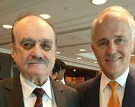India and Australia are ideally placed to develop a close, comprehensive partnership so as to take advantage of the opportunities that are now available in a world where the economic and political gravity is shifting towards the Indo-Pacific region. Few countries in the Indo-Pacific have more in common than India and Australia. They speak the same language, respect the same system of law and are both multicultural, federal democracies. With this in mind the first Australia India Leadership Dialogue was held in New Delhi in the year 2015.
In continuation with this thought, the second Australia India Leadership Dialogue was held in Melbourne on 05 December 2016. The dialogue was conducted over four sessions namely, ‘Session 1 – Politics Update’, ‘Session 2 – How to Increase Mutual Trade and Investment, and Business Co-Operation’, ‘Session 3 – Evolving Security Architecture in the Region’, and the ‘Closing Session– Summary of Key Discussion Points and Next Steps’.
The said dialogue was attended by senior leaders from both the nation’s government, business and civil society. On behalf of the Vivekananda International Foundation (VIF), Lt Gen Ravi Sawhney attended the dialogue. During the dialogue, the delegates discussed a wide range of topics of mutual interests such as geo-strategic interests, regional security architecture, trade and investment, energy, education and skills, water & food, agriculture and agro-processing, and infrastructure.
Talk by Lt Gen Ravi Sawhney, Dean Center for Defence Studies, VIF
Lt Gen Ravi Sawhney was the lead speaker for the Session 3 – ‘Evolving Security Architecture in the Region’, and delivered a talk on the ‘Security Architecture for the Asia Pacific’. Speaking on the issue, he brought out that the strategic and economic landscape of the Asia Pacific was rapidly changing on account of the rapid rise of Asia as an economic power-house. Due to this it has become clear that the Asia Pacific region would exert increasing influence on the global politico-economic scenario. In view of this it was imperative that the region strengthens mechanisms to safeguard its economic growth and security.
Gen Sawhney explained that at present in the Indo Pacific, China’s rise and increasing assertiveness supported by a rapid military modernization is a cause for concern for all. Till date, the US is being seen as a guarantor for peace and stability for the region. The rise of China and other Asian power’s rise has led to the geo-strategic focus shifting from the Atlantic to the Pacific. In view of this the US announced its ‘Asian Pivot’ strategy which saw India as an anchor and lynchpin. The importance of safeguarding maritime security and ensuring freedom of navigation and over-flight throughout the region and especially in the South China Sea, was thus highlighted. The future of the US’s Asia policy, is however unclear after the divergent views being expressed by the President elect Mr Donald Trump.
Elaborating further, the speaker brought out that the imperatives for intra-regional integration were clear and ranged from inhibited flow of maritime trade to countering piracy. India on its part has undertaken its ‘Act East’ policy and has reached out to ensure intra-regional integration. While there are various mechanisms for regional maritime security, the diversity of the region and its geographical expanse precludes the development of an all-encompassing security architecture. On the other hand, larger nations like India, Japan and Australia along with the US already have a security dialogue amongst themselves, albeit, either bilaterally or trilaterally. Therefore, the way forward, in his view, was to expand this dialogue and leverage the already existing linkages in a larger Indo-Pacific context and thereby take a logical step towards developing a common security framework for the region.
Conclusion
The second Australia India Leadership Dialogue concluded with a lot of positives and takeaways. The dialogue built deeper co-operation, closer friendships and stronger relationships based on trust between leaders in government, business and civil society from India and Australia. This purpose was achieved through open discussions which identified new ways and opportunities for both the countries to work together on in the coming years.



